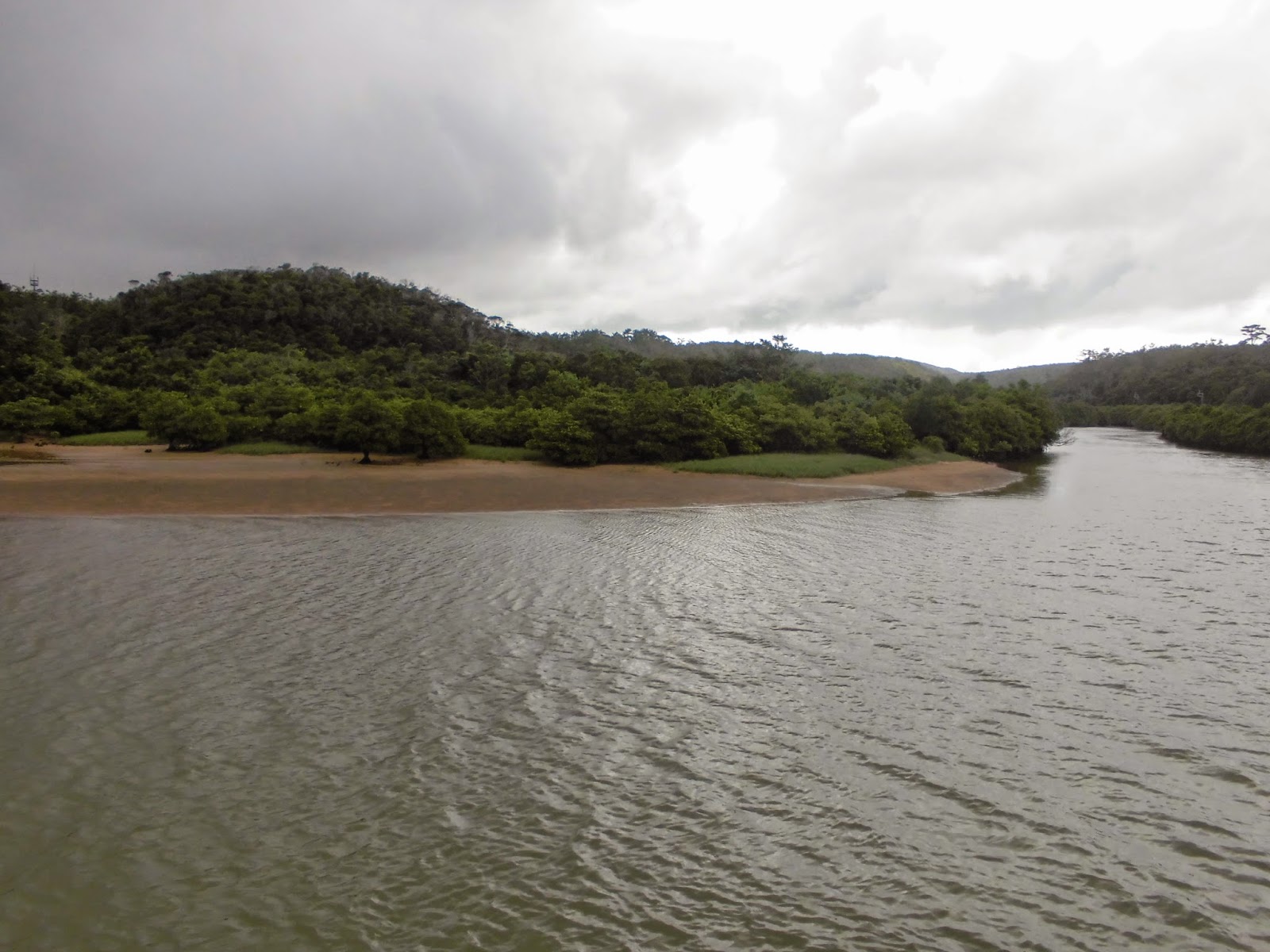Masao Shimabukuro gives us a sendoff as we head into the mangroves.
島袋先生と別れて、マングローブに入って行こう。
ㄅㄞㄅㄞ島袋老師。
Okinawa used to have mangroves all around the island, but most of them were destroyed by human activity. However, in recent years, people have started to see the value in intact mangroves (for storm protection, keeping the water clean, etc.) and there are some places where they've started to regrow them. One of those places is in Higashi.昔は沖縄の周りがほとんどマングローブだったそうだ。でも経済発展にそってだんだん壊された。しかし、最近マングローブの復活に力を入れている地域がある。マングローブは浸食や津波から土地を守るし、海のフィルターの様に水を綺麗にしてくれる。ここは東村のヒルギ公園だ。
以前沖繩有很多紅樹。但是發展的關係,越來越少了。跟台灣一樣,最近人注意到了紅樹會幫人的事情。紅樹也保護土地不會受到海嘯的影響,也像過濾一樣,會讓水漂亮了。在東村他們幫紅樹再生長了。
A squall(?) came through. It passed in about 10 minutes though.
急に雨が強く降ってきた。
忽然下了大雨。
A mudskipper!
ムツゴロウ(鯥五郎という漢字があるみたい。二郎とか三郎とかもあるかな?)
彈塗魚
It turns out that photos of mangroves just look like big messes of trees, because, you know, that's what mangroves are.
マングローブの写真は正直、あまり面白くないと後で気付いた。木がめちゃくちゃに生えているだけなのだから。
...but if you mess around with the contrast and exposure on the photo, you get art!
、、、でも写真のコントラストと露出で遊んだら、こんな写真が出来る!
我把這一張照片的對比度和爆光弄高了,變成一張有趣的。
赤いやつはもしかして後で落ちて新しい木に生えるだろう。
I could be wrong, but I think these red, pointy things might be the parts that fall off and grow into new trees.
Unlike in the rest of Japan, you don't see torii (the gate thing) like the one below very often. Shinto was introduced to Okinawa when it was annexed by Japan in the late 19th century. Traditional Okinawan sacred spaces are usually unmarked by anything except maybe a small wall of stones, or a space to leave incense.
沖縄では鳥居をあまり見掛けない。たしか明治時代の琉球処分以降に神道と一緒に入ってきたものだと思う。琉球の本来の宗教なら、聖域に別に鳥居を建てない。時々お香を焚く為の平たい石しか設置していない。
下面的東西叫做鳥居(ㄊㄡㄌㄧ)。在日本並不少,但是在琉球群島真的很少。鳥居是在神社(日本的廟)前面設備的。因為神道是日本本土的宗教,琉球原本沒有。在琉球的聖地平常什麼東西都沒有。可能只有為了放香的石頭而已。
These photos are from the town of Ginoza. It's a small town, and there's a big American base nearby, so a lot of the businesses have English written on them. Still, it seems like the town's heyday was a couple of decades ago (maybe even as far back as the Vietnam War, when Okinawa's American soldier population peaked) and a lot of the stores seem kind of run down.
東海岸の宜野座村にも行ってみた。近くに大きな米軍基地があるので、アメリカ人向け、英語の看板がたくさんあった。でもこの町の最盛期はたぶん何十年前だった。かなり寂れた様な感じがする。(でもアメリカ人として、ちょっと懐かしい感じもする。)
這裡是宜野座村。在附近有一個美軍的基地,所以有一些店有英文字。但是因為這個鎮村看起來門可羅雀所以,我猜這裡的繁榮時應該已經過了。有可能最盛期是越南戰爭的時候。當時美軍比現在更多了。
Nearby Camp Schwab.
シュワブ基地。
ㄕㄨㄚㄅㄜ基地
Some road construction was being done near the base. Japanese construction signs like this don't usually have English written on them.
基地が近いから、工事中の標識にも英語が書いてある。
日本的「小心施工」的標誌平常沒有英文。是因為離基地很近。
I headed to Sesoko Island, just off the north west coast of Okinawa and connected by a bridge. It's a small island with lots of places to stay and nice beaches, but that's about it.
最後に瀬底島に行ってみた。ビーチと宿以外はあまり何もない。
最後去瀨底島。它是很小的島,跟沖繩是橋聯繫的。
To the right of the dark land on the horizon (part of Okinawa) you can see Ie Island.
また伊江島が見えた。右側に微かに写っている。
又看到了伊江島。在右邊。
Tortoise Beach
I found what I think is a coconut crab. It's too big to be a hermit crab I'm pretty sure.
ヤシガニを見付けた!でかいから、たしかヤドガリじゃないと思う。
椰子蟹!
Pretty cool, huh? More next time.
また今回!
下次還有!
また今回!
下次還有!







































No comments:
Post a Comment